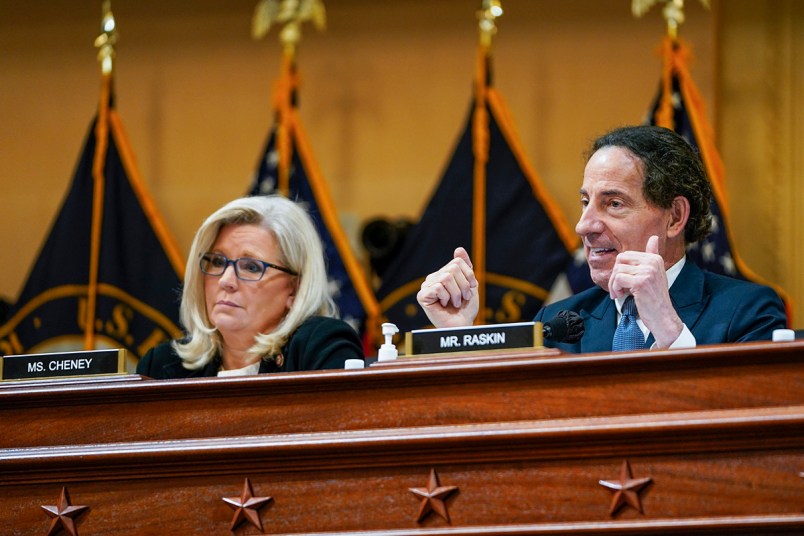The Jan. 6 Committee concluded its blockbuster public hearings and presentations with a flourish Monday, voting to refer criminal charges against former President Donald Trump and lawyer John Eastman to the Department of Justice.
Committee Referrals
It’s the first time in American history such a referral has been made against a former president. The committee members voted to tie Trump to four charges: obstruction of an official proceeding, conspiracy to defraud the United States, conspiracy to make a false statement and inciting or assisting with an insurrection.
They also voted to refer the first two charges against Eastman, one of the key architects of the fake electors scheme.
The 150-page executive summary of the report, released after the meeting concluded, holds more details on the referrals — and on the other individuals that the committee alleges were involved in the crimes. Rep. Jamie Raskin (D-MD) said in comments during and after the meeting that “others” involved in Trump’s orbit might be responsible too.
In the section on the first charge, obstruction of an official proceeding, former Trump lawyer Kenneth Chesebro and Rep. Scott Perry (R-PA) make an appearance.
“Others working with Eastman likely share in Eastman’s culpability,” the summary reads. “For example, Kenneth Chesebro was a central player in the scheme to submit fake electors to the Congress and the National Archives,” later adding: “The Committee notes that multiple Republican Members of Congress, including Representative Scott Perry, likely have material facts regarding President Trump’s plans to overturn the election.”
For the next charge, conspiracy to defraud the United States, the committee writes that “Jeffrey Clark stands out as a participant in the conspiracy.”
It then lists other figures who the conspiracy “appears to have included”: Chesebro, Mark Meadows and Rudy Giuliani.
Eastman and Chesebro pop up again as “co-conspirators” under the conspiracy to make a false statement charge, the two seemingly having attracted much of the committee’s attention.
And the committee doesn’t stop with the referrals read aloud by Raskin in public; it recommends two additional charges against Trump, should the Justice Department have the resources to make the case.
“The Department of Justice, through its investigative tools that exceed those of this Committee, may have evidence sufficient to prosecute President Trump under Sections 372 and 2384,” the summary reads, referring to statutes prohibiting stopping officers of the United States from doing their duties and seditious conspiracy, respectively. “Accordingly, we believe sufficient evidence exists for a criminal referral of President Trump under these two statutes.”
The committee notes that Meadows, who refused to testify before the committee, may have “specific evidence” to help bring the first charge.
What Referrals Can And Can’t Do
The referrals do not bind the Justice Department to taking any prosecutorial action. While the committee members hope that naming the targets and detailing their alleged misdeeds will be politically potent, helping to build public support for the cases and pressure on the DOJ to pursue the lines of inquiry, the Department is free to ignore the recommendations.
Separately, Raskin said that four members of Congress will be handed over to the House Ethics Committee for ignoring the Jan. 6 committee’s subpoenas: Reps. Scott Perry (R-PA), Jim Jordan (R-OH), Andy Biggs (R-AZ) and House Minority Leader Rep. Kevin McCarthy (R-CA).
The DOJ is also already investigating many of the same threads as the committee; last month, Attorney General Merrick Garland named Jack Smith as special counsel charged with plumbing Trump’s role in the Jan. 6 insurrection and his handling of government documents at Mar-a-Lago.
And Smith has wasted little time since his appointment. In recent weeks, he has issued a federal grand jury subpoena for testimony from Georgia Secretary of State Brad Raffensperger, got former White House Counsel Pat Cipollone and his top lieutenant, Patrick Philbin, to testify before the grand jury and subpoenaed officials in 2020 battleground states to obtain records of their communications with Trump and his campaign.
Perhaps of more use to the Justice Department than the referrals will be the full report and accounting of the committee’s findings over an 18-month investigation, expected to be released publicly this week.
Still, ending the committee’s public presentations with such votes — mirroring the mid-October televised vote to subpoena Trump for his testimony — is meant to be more than just functional: it’s symbolic. For both posterity and public consumption, the committee is naming and shaming those it’s found to be most directly culpable for the pro-Trump mob’s attack on the Capitol that left several dead, more wounded and many participants facing jail time.
The committee has been credited with increasing the salience of the attacks many months after the fact, a feat all the more impressive given Trump and the Republican Party’s interest in downplaying and dismissing the violence.
While it may lack legal might, the committee is mustering its prodigious flair for the dramatic and compelling as it concludes its public work with the referral crescendo — just weeks before Republicans take over the House and either disband it or turn it to their own political ends.
This post has been updated with details from the committee’s executive summary of its final report, to be released in full later this week.



